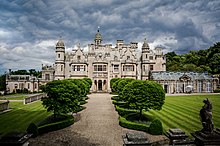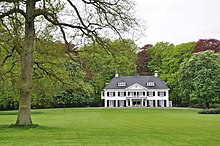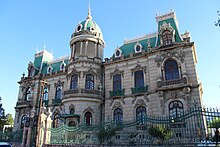Mansion


Amansionis a large dwellinghouse.The word itself derives throughOld Frenchfrom theLatinwordmansio"dwelling", an abstract noun derived from the verbmanere"to dwell". The English wordmanseoriginally defined a property large enough for the parish priest to maintain himself, but a mansion is no longer self-sustaining in this way (compare a Roman or medievalvilla).Manorcomes from the same root—territorial holdings granted to a lord who would "remain" there. Following the fall of Rome, the practice of building unfortified villas ceased. Today, the oldest inhabited mansions around the world usually began their existence asfortified housesin theMiddle Ages.As social conditions slowly changed and stabilisedfortificationswere able to be reduced, and over the centuries gave way to comfort. It became fashionable and possible for homes to be beautiful rather than grim and forbidding allowing for the development of the modern mansion.
In British English, a mansion block refers to a block of flats orapartmentsdesigned for the appearance of grandeur.[1][2]In many parts of Asia, including Hong Kong and Japan, the word mansion also refers to a block of apartments. In modern Japan, a "manshon" (Japanese:マンション), stemming from the English word "mansion", is used to refer to a multi-unit apartment complex orcondominium.
15th to 18th-century development[edit]

In Europe, from the 15th century onwards, a combination of politics and advances in weaponry negated the need for the aristocracy to live in fortified castles. As a result, many were transformed into mansions without defences or demolished and rebuilt in a more modern, undefended style. Due to intermarriage and primogeniture inheritance amongst the aristocracy, it became common for one noble to often own severalcountry houses.These would be visited rotationally throughout the year as their owner pursued the social and sporting circuit from country home to country home.[3]Many owners of a country house would also own a town mansion in their country's capital city. These town mansions were referred to as 'houses' in London, 'hôtels particuliers' in Paris, and 'palaces' in most European cities elsewhere. It might be noted that sometimes the house of a clergyman was called a "mansion house" (e.g., by the Revd. James Blair, Commissary in Virginia for the Bishop of London, 1689–1745, a term related to the word "manse" commonly used in the Church of Scotland and in Non-Conformist churches. H.G. Herklots, The Church of England and the American Episcopal Church).[citation needed]

As the 16th century progressed and theRenaissance styleslowly spread across Europe, the last vestiges of castle architecture and life changed; the central points of thesegreat housesbecame redundant as owners wished to live separately from their servants, and no longer ate with them in a Great hall. All evidence and odours of cooking and staff were banished from the principal parts of the house into distant wings, while the owners began to live in airy rooms, above the ground floor, with privacy from their servants, who were now confined, unless required, to their specifically delegated areas—often the ground and uppermost attic floors. This was a period of great social change, as the educated prided themselves on enlightenment.[4]
The uses of these edifices paralleled that of theRoman villas.It was vital for powerful people and families to keep in social contact with each other as they were the primary moulders of society. The rounds of visits and entertainments were an essential part of the societal process, as described in the novels ofJane Austen.State business was often discussed and determined in informal settings. Times of revolution reversed this value. During July/August 1789, a significant number of French country mansions (chateaux) were destroyed by the rural population as part of theGreat Fear—a symbolic rejection of the feudal rights and restraints in effect under theAncien Régime.[5]
UntilWorld War Iit was not unusual for a moderately sized mansion in England such asClivedento have an indoor staff of 20 and an outside staff of the same size,[citation needed]and inducalmansions such asChatsworth Housethe numbers could be far higher. In the great houses of Italy, the number of retainers was often even greater than in England; whole families plus extended relations would often inhabit warrens of rooms in basements and attics. Most European mansions were also the hub of vastestates.[citation needed]
19th-century development[edit]
This sectionneeds additional citations forverification.(July 2021) |

The 19th century saw the continuation of the building of mansions in the United States and Europe. These mansions were often smaller than those built by the old European aristocracy. The new builders of mansions at the time explored new styles other than the Gothic tastes in architecture which were used often. They experimented with 19th-century versions of older Renaissance and Tudoresque styles;The BreakersinRhode Islandis an example of American Renaissance revivalism.
During the 19th century, along with other streets in major cities,Fifth Avenuein New York City had many mansions. Many of these were designed by the leading architects of the day, often in EuropeanGothic Revival style,and were built by families who were making their fortunes. However, nearly all of these have now been demolished.Whitemarsh Hall,a countryside estate in the U.S. was demolished in 1980, along with its extensive gardens, to make way for suburban developments. In Paris, London orRome,many large mansions and palazzi built or remodeled during the era still survive.
GrandFederal stylemansions designed bySamuel McIntireinhabit an area that, in 2012, is the largest collection of 17th- and 18th-century structures in the United States of America. This district inSalem, Massachusetts,is called theMcIntire Historic Districtwith the center being Chestnut Street.[6]McIntire's training came from his father and from books. He and his brothers, Joseph and Angler, began their careers as housewrights and carpenters while in their teens but, early on, Samuel's work caught the eye of Salem's pre-eminent merchant, Elias Hasket Derby. Over the next quarter century, McIntire built or remodelled a number of homes for Derby and members of his extended family. McIntire also worked occasionally on Derby's vessels, and would fix a wagon or build a birdhouse if his patron desired.[7]Hamilton Hallis aNational Historic Landmarkat 9 Chestnut Street inSalem, Massachusetts.Hamilton Hall was built in 1805 bySamuel McIntireand added to theNational Register of Historic Placesin 1970.[8][9]"King" Derby's stamp of approval opened many other doors for McIntire, who went on to design and build mansions for John Gardner, Jerethmiel Peirce, Simon Forrester, and other wealthy Salem shipowners. He also built on Chestnut Street a function hall (named for Alexander Hamilton) and a church for the town's merchant class. McIntire also designed the former Salem Court House and Registry of Deeds.
After 1793, Samuel McIntire worked exclusively in the architectural style developed byRobert Adamin Great Britain and brought to America by the great Boston architect, Charles Bulfinch. The delicateAdam style,which emphasized decorative elements and ornamentation, was preferred for McIntire, who was efficient in design and proportions and had skill as a woodcarver. Swags, rosettes, garlands, and his signature sheaths of wheat were carved in wood surfaces in McIntire homes built between 1793 and his death in 1811.

In Europe, some 19th-century mansions were often built as replicas of older houses; theChâteau de Ferrièresin France was inspired byMentmore Towers,which in turn is a copy ofWollaton Hall.Other mansions were built in the new and innovative styles of the new era such as thearts and craftsstyle: The Breakers is a pastiche of anItalian Renaissancepalazzo;Waddesdon Manorin Buckinghamshire is a mixture of various Frenchchâteaux.One of the most enduring and most frequently copied styles for a mansion is thePalladian– particularly so in the 18th century. However, theGothic stylewas probably the most popular choice of design in the 19th century. The most bizarre example of this was probablyFonthill Abbeywhich actually set out to imitate the mansions which had truly evolved frommedievalGothicabbeysfollowing theDissolution of the Monasteriesin the 16th century.
Mansions built during and after the 19th century were not supported by the large estates of their predecessors. These new mansions were often built as the week-end retreats of businessmen who commuted to their offices by the new railways, which enabled them to leave the city more easily.[citation needed]
Latin America[edit]

In Latin America, the grand ruralestate,theHacienda,Estancia, inPortuguesespeaking Brazil Fazenda or Estância, with the mansion as its stately center, is a characteristic feature.
Mansions tended to follow Europeanarchitectural styles.Whereas until the second half of the 19th century, Portugal and Spain as the colonial (or former colonial) powers were the eminent models for architecture and upper-class lifestyle, towards the end of the 19th century they were sometimes replaced by then more dominant powers like France or England.
In comparably developed, densely populated countries like Mexico, feudal estates and their mansions were as grand and stately as in theMediterraneanold world, whereas where estates were founded in the sparsely populated remote areas like the Pampa of Argentina or Uruguay, where iron pillars, doors, windows, and furniture had to be brought from Europe by ship and afterwards ox cart, buildings were smaller, but normally still aspiring to evoke a stately impression, often featuring, like their earlier Italian counterparts, amorador.
In Venezuela, the traditional Spanish mansions with a garden in the center of the property are usually referred as "Quinta".
Size[edit]
Some realtors in the US term mansions as houses that have a minimum of 8,000-square-foot (740 m2) of floor space.[10]Others claim a viable minimum could instead be 5,000-square-foot (460 m2) of floor space, especially in a city environment.[11]
See also[edit]
References[edit]
- ^"What is a mansion block".OurProperty.Retrieved23 September2020.
- ^"Mansion blocks are real British antiques..."City AM.9 July 2015.Retrieved23 September2020.
- ^Girouard, Mark(1978).Life in the English Country House.New Haven, CT: Yale University Press.ISBN0-300-02273-5.
- ^Halliday, F. E. (1967).Cultural History of England.London: Thames and Hudson. p. 166.
- ^Richard Cobb, pages 77–79,The French Revolution: Voices from a Momentous Epoch,CN8039, Guild Publishing 1988
- ^"Salem Massachusetts – Salem Architecture Salem Architecture: McIntire".Salemweb.Retrieved18 August2013.
- ^"Salem Massachusetts – Salem Architecture 17th & 18th Centuries: Overview".Salemweb.Retrieved18 August2013.
- ^"National Register Information System".National Register of Historic Places.National Park Service.15 April 2008.
- ^"Hamilton Hall NHL listing info".Tps.cr.nps.gov. 30 December 1970. Archived fromthe originalon 6 June 2011.Retrieved18 August2013.
- ^"What Is a Mansion? The Luxury Home Next Door Might Not Qualify".Real Estate News & Insights | realtor ®.16 October 2019.
- ^Staff Writer (4 August 2015)."How Many Square Feet Are in a Mansion?".reference.
External links[edit]
- Historic Mansions and Estates in Latin America
- Estonian Manors Portalthe English version introduces 438 well-preserved historical manors (mansions, estates) in Estonia
